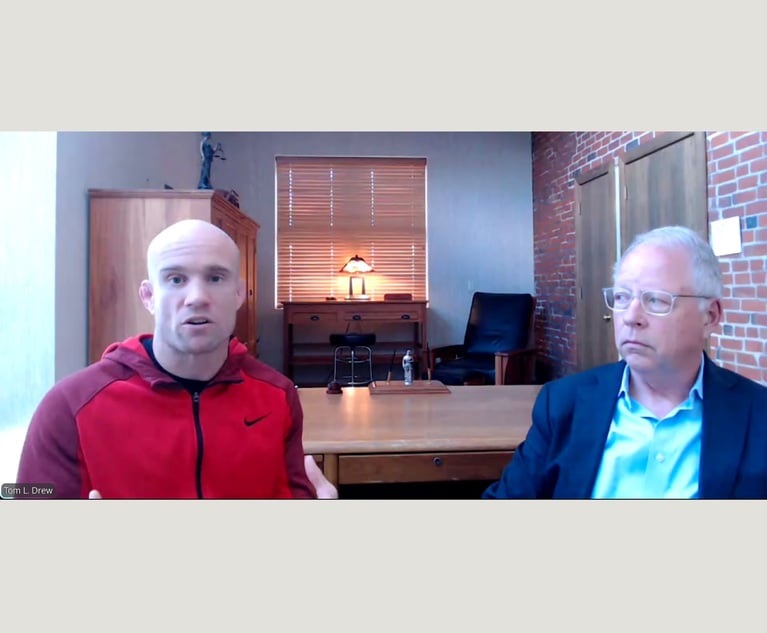 Michael J. Abrams partner with Lathrop Gage.
Michael J. Abrams partner with Lathrop Gage.Daily Dicta: As Lawsuits by Exonerated Prisoners Add Up, These Lawyers Help Them Collect
As indefatigable lawyers—and DNA evidence—continue to win exonerations for those wrongly convicted, Mike Abrams and his colleagues at Lathrop Gage have carved out a niche helping ex-prisoners win--and collect--compensation for civil rights violations.
June 03, 2019 at 01:17 PM
7 minute read
Few fates are worse than serving decades in prison for a crime you didn't commit. How do you put a price tag on a wrongful conviction? And who pays?
As indefatigable lawyers—and DNA evidence—continue to win exonerations for those wrongly convicted, Mike Abrams and his colleagues at 300-lawyer Lathrop Gage have carved out a niche.
Working on contingency, they represent exonerated prisoners suing for civil rights violations, with a focus on insurers—the ones providing coverage for the cities and counties and states responsible for the wrongful convictions—to compel them to cover what can be eight-figure judgments.
“For our team, this is by far the most satisfying work we're involved in,” Abrams said, estimating that such cases now make up about 20 percent of his practice. Since 2004, lawyers at the Kansas City, Missouri-based firm have helped recover more than $190 million for wrongly convicted people, including $60.6 million in January for the “Englewood Four” in Illinois and $21 million for Craig Coley in California in February.
Abrams and partners Bill Beck and Alex Brown along with co-counsel from Neufeld, Scheck & Brustin scored their latest victory last week on behalf of the estates of three men wrongly accused of raping and murdering a woman in Forrest County, Mississippi in 1979.
The men (who have all since died) were exonerated by DNA evidence after serving a combined 83 years in prison. Their families settled with Mississippi authorities for $16.5 million, with the potential for $4 million more.
 The U.S. Court of Appeals for the Fifth Circuit on May 29 ruled that Travelers Insurance and Scottsdale Insurance have a duty to defend Forrest County and its officers in the suit. According to Abrams, that means the insurers will be “obligated to settle for a reasonable amount.”
The U.S. Court of Appeals for the Fifth Circuit on May 29 ruled that Travelers Insurance and Scottsdale Insurance have a duty to defend Forrest County and its officers in the suit. According to Abrams, that means the insurers will be “obligated to settle for a reasonable amount.”
It's a significant decision for other exonerated prisoners seeking compensation—a population that (depressingly) continues to grow—as well as cash-strapped local authorities that don't have the money to cover the judgments. Forrest County, which has a median household income of $39,555, has already raised taxes to help cover the penalty, Abrams said.
It's worth pointing out that these cases represent the most profound failure of the justice system. Innocent lives are ruined, the guilty go free (and often hurt others) and taxpayers are stuck with the tab—unless insurance companies can be forced to share some of the burden.
Writing for the unanimous panel, Judge Gregg Costa began by describing the underlying case: “The first tragedy occurred in May 1979 when Eva Gail Patterson, a 25- year-old mother of two, was raped and murdered in her home. Her two sons watched her die. The second tragedy began when officers of the Forrest County Sheriff's Department targeted Larry Ruffin for the crime.”
At the time, Ruffin was an inmate at a restitution center, where he was working to compensate the victim of a minor theft. According to Costa's decision, local police locked him up for two days and threatened another restitution center inmate with additional charges unless he implicated Ruffin.
Armed with the fabricated statement, the officers arrested Ruffin and then “beat, punched, kicked, slapped, and hurled racial slurs and death threats” at him for seven hours until he confessed.
Although the victim's son said only one man committed the crime, police went on to arrest Bobby Ray Dixon, who was mentally handicapped as a result of being kicked in the head by a horse as a child, and Phillip Bivens. Both were also beaten and threatened until they confessed.
“Bivens and Dixon pleaded guilty. Ruffin was convicted at trial. All three got life sentences,” Costa wrote.
And then, in 2008, a guard at the state prison in Parchman, Mississippi contacted the Innocence Project on Dixon's behalf. According to Abrams, it was a three-minute phone call. “He said he'd been a guard for decades, and there was no way [Dixon] committed these crimes, and that they should look into this,” Abrams said, adding that Dixon “was a gentle soul.”
The Innocence Project took the case and ran DNA tests on sperm from the victim's rape kit. It matched Andrew Harris, who was serving a life sentence for a rape he committed after the attack on Eva Gail Patterson.
Ruffin, Dixon and Bivens were cleared. But it was too late for Ruffin, who died eight years earlier in prison from an electric shock. Dixon had been released on medical parole, but died five weeks before he was officially exonerated. Bivens spent a mere three years as a free man before he died in 2014 at the age of 63.
Their estates sued Forrest County, the City of Hattiesburg, and several individual officers for civil rights violations, reaching the $16.5 million settlement in 2016.
But who would pay?
Forrest County over the years had purchased a series of law enforcement liability policies. The question before the Fifth Circuit: When are the policies triggered?
The wrongful act—when Ruffin, Dixon and Bivens were arrested, charged and falsely convicted—occurred years before the policies were in effect.
But the plaintiffs said their injuries as prisoners continued to occur when Scottsdale provided coverage from November 1985 through November 1986, and when a Travelers subsidiary provided insurance from February 2005 through February 2011. For example, during this time Ruffin in prison was infected with syphilis and herpes and Bivens got Hepatitis C. All three suffered from other physical and mental ailments that they blamed on prison conditions.
Could the two insurers based on language specific to their policies be on the hook for damages under a “continuous trigger” theory?
Travelers argued that every other court to address the issue “has resoundingly rejected” the theory.
“[T]he 'continuous trigger' theory was developed to address latent injury claims such as asbestos bodily injury where there is a long latency period between exposure to injurious conditions and manifestation of the injury,” wrote Dennis M. Dolan of Litchfield Cavo for Travelers on appeal.
“In wrongful imprisonment cases there is no latency,” he continued. “Injury—loss of liberty and exposure to prison conditions—is immediately manifested. Therefore, the 'continuous trigger' theory has no application in these types of cases.”
The Fifth Circuit disagreed. Travelers “bargained for an injury-based trigger of coverage, not an act-based trigger. Under the policy's plain terms, Travelers must defend any claim in which covered injuries occurred between 2005 and 2011, regardless of when the wrongful causal act occurred,” the panel ruled, upholding the district court's decision.
The panel reached a similar conclusion with respect to Scottsdale.
As is typical in such cases, Abrams said the litigation made for “strange bedfellows.” His clients' interests here were aligned with Forrest County—the ones ultimately responsible for their harm.
While Lathrop Gage only represents exonerated prisoners, Abrams said many government entities “want to do the right thing,” he said. “We have a common goal.”
This content has been archived. It is available through our partners, LexisNexis® and Bloomberg Law.
To view this content, please continue to their sites.
Not a Lexis Subscriber?
Subscribe Now
Not a Bloomberg Law Subscriber?
Subscribe Now
NOT FOR REPRINT
© 2024 ALM Global, LLC, All Rights Reserved. Request academic re-use from www.copyright.com. All other uses, submit a request to [email protected]. For more information visit Asset & Logo Licensing.
You Might Like
View All

Helping Lawyers Move Away from ‘Grinding’ and Toward a ‘Flow’

Why Litigation Demand Might Break Firms’ Boom-and-Bust Cycle
Trending Stories
- 1DOJ Asks 5th Circuit to Publish Opinion Upholding Gun Ban for Felon
- 2GEO Group Sued Over 2 Wrongful Deaths
- 3Revenue Up at Homegrown Texas Firms Through Q3, Though Demand Slipped Slightly
- 4Warner Bros. Accused of Misleading Investors on NBA Talks
- 5FTC Settles With Security Firm Over AI Claims Under Agency's Compliance Program
Who Got The Work
Michael G. Bongiorno, Andrew Scott Dulberg and Elizabeth E. Driscoll from Wilmer Cutler Pickering Hale and Dorr have stepped in to represent Symbotic Inc., an A.I.-enabled technology platform that focuses on increasing supply chain efficiency, and other defendants in a pending shareholder derivative lawsuit. The case, filed Oct. 2 in Massachusetts District Court by the Brown Law Firm on behalf of Stephen Austen, accuses certain officers and directors of misleading investors in regard to Symbotic's potential for margin growth by failing to disclose that the company was not equipped to timely deploy its systems or manage expenses through project delays. The case, assigned to U.S. District Judge Nathaniel M. Gorton, is 1:24-cv-12522, Austen v. Cohen et al.
Who Got The Work
Edmund Polubinski and Marie Killmond of Davis Polk & Wardwell have entered appearances for data platform software development company MongoDB and other defendants in a pending shareholder derivative lawsuit. The action, filed Oct. 7 in New York Southern District Court by the Brown Law Firm, accuses the company's directors and/or officers of falsely expressing confidence in the company’s restructuring of its sales incentive plan and downplaying the severity of decreases in its upfront commitments. The case is 1:24-cv-07594, Roy v. Ittycheria et al.
Who Got The Work
Amy O. Bruchs and Kurt F. Ellison of Michael Best & Friedrich have entered appearances for Epic Systems Corp. in a pending employment discrimination lawsuit. The suit was filed Sept. 7 in Wisconsin Western District Court by Levine Eisberner LLC and Siri & Glimstad on behalf of a project manager who claims that he was wrongfully terminated after applying for a religious exemption to the defendant's COVID-19 vaccine mandate. The case, assigned to U.S. Magistrate Judge Anita Marie Boor, is 3:24-cv-00630, Secker, Nathan v. Epic Systems Corporation.
Who Got The Work
David X. Sullivan, Thomas J. Finn and Gregory A. Hall from McCarter & English have entered appearances for Sunrun Installation Services in a pending civil rights lawsuit. The complaint was filed Sept. 4 in Connecticut District Court by attorney Robert M. Berke on behalf of former employee George Edward Steins, who was arrested and charged with employing an unregistered home improvement salesperson. The complaint alleges that had Sunrun informed the Connecticut Department of Consumer Protection that the plaintiff's employment had ended in 2017 and that he no longer held Sunrun's home improvement contractor license, he would not have been hit with charges, which were dismissed in May 2024. The case, assigned to U.S. District Judge Jeffrey A. Meyer, is 3:24-cv-01423, Steins v. Sunrun, Inc. et al.
Who Got The Work
Greenberg Traurig shareholder Joshua L. Raskin has entered an appearance for boohoo.com UK Ltd. in a pending patent infringement lawsuit. The suit, filed Sept. 3 in Texas Eastern District Court by Rozier Hardt McDonough on behalf of Alto Dynamics, asserts five patents related to an online shopping platform. The case, assigned to U.S. District Judge Rodney Gilstrap, is 2:24-cv-00719, Alto Dynamics, LLC v. boohoo.com UK Limited.
Featured Firms
Law Offices of Gary Martin Hays & Associates, P.C.
(470) 294-1674
Law Offices of Mark E. Salomone
(857) 444-6468
Smith & Hassler
(713) 739-1250







